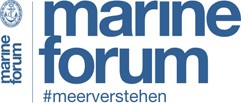This is followed by the first-placed entry in the DMI essay competition by Lieutenant Captain Mark Baumert:
A century at sea?
by Lieutenant Captain Mark Baumert
The 21st century has recently been predicted to be the century of Asia and the emerging markets, the century of increasing digitalisation of our everyday lives and the century of renewable energies, to name just three examples. Predictions such as these are now recognised by society as a whole and are often accepted as a guiding forecast, whether in the area of investment or the orientation of companies. However, forecasts of supposedly significant developments are also characterised by the profession and world view of the forecaster. For example, the Institute for Applied Physics at the University of Bonn expects a "century of the photon", the Bavarian State Women's Committee hopes for a "century of women" and the Heiligenfeld Academy in Bad Kissingen, a spiritual training centre with the aim of "expanding consciousness" and "personal growth", expects a "century of consciousness".
A century with many names.
Wishful thinking or ambassador of reality?
For some time now, maritime trade journals, conferences on maritime topics and individual articles in national daily newspapers have stated that the increasing foreign trade of the Federal Republic of Germany has been accompanied by a change in the importance of maritime shipping and its security. Here, too, there is talk of a century, namely the "maritime 21st century". Although this economic sector has always been important for Germany's development anyway, it will become even more significant as a result of the ever-increasing globalisation and export orientation of German companies. In the same breath, as recently emphasised in the article "No land in sight?" in the Frankfurter Allgemeine Zeitung by the group of authors Vice Admiral (ret.) Feldt, Vice Admiral (ret.) Stricker, Prof. Dr Masala, Tsetsos M.A. states that in Germany there is only a marginal interest in this essential economic sector and thus in matters of maritime security policy.
But isn't the maritime industry and the German Navy perhaps also subject to the compulsion to secure its own existence in the competition for public funding? And does this perhaps narrow the perspective on maritime issues? Or do the experts in this sector paint a more accurate picture, namely that of a maritime 21st century that is actually taking place, especially for the Federal Republic of Germany?
Challenges of the maritime economy
Let us first consider the economic importance of the maritime sector for the Federal Republic of Germany: several hundred thousand employees, a rapidly growing tourism industry, a high level of German financial capital in international maritime shipping and an undoubtedly important economic sector for Germany's foreign trade. But what is the current state of the industry? Is this industry fit for the future?
How from the Third Report of the Federal Government on the Development and Future Prospects of the Maritime Industry in Germany February/2013 The last few years have been changeable and difficult for the global economy, but especially for the German maritime industry. In the years leading up to the global economic crisis until the end of 2008, the maritime sector was characterised by high order numbers, shipping was characterised by high demand for shipping space and, in the container sector in particular, high freight and charter rates meant that handling records were set in some cases. With the subsequent economic slump in 2009 due to the global economic and financial crisis, the positive key figures for the maritime sector in particular also declined. As the maritime industry is tied to the global economy to a much greater extent than other sectors due to its inherent international orientation, this slump in 2009 also led to a massive decline in demand for shipping space and orders for new ships.
Although there was an unexpectedly strong recovery in 2010, turnover in the maritime industry fell again in 2011 and 2012. As numerous new ships were ordered during the "boom years", part of the global merchant fleet is now unemployed. Based on 4961 full container ships operating worldwide and a total global transport capacity of 16.4 million TEU, this means that at the end of 2012, a high volume of 810,000 TEU remained unutilised compared to previous years. In addition, the order situation in container shipbuilding remains at a low level due to enormous overcapacity in Asia. However, shipyards in Germany have been able to hold their own in the market, largely by switching from container shipbuilding to specialised shipbuilding. Offshore wind energy and the associated infrastructural measures as well as the cruise ship industry also offer good growth figures in the German maritime industry.
Overall, it can be stated that the maritime industry in Germany has taken on the challenges of the present despite volatile and rough seas and has positioned itself well in a global comparison. However, this does not apply to the entire industry. The situation for shipbuilding suppliers, especially for those suppliers that are heavily dependent on standard ship newbuilds, remains difficult in the medium term.
Mineral resources, shipping routes and world trade
Although world trade is currently stagnating, not least due to the euro crisis, it can be assumed that the trend towards more international trade will continue in the future as globalisation increases. And this is largely based on maritime logistics. The international division of labour and production is also increasing. But it is not only world trade that will increase; conflicts over marine resources will also continue to intensify. In East Asia, for example, China's increasing influence in the region - the conflict over the South China Sea is just one example - is forcing neighbouring countries to upgrade their navies in particular. For countries such as China, Japan, the Philippines and South Korea, the surrounding sea is essential and securing their shipping routes and seabed resources is of great importance. The maritime space between these countries will continue to harbour potential for conflict in the future. But not only here, all over the world the sea is seen as an exploitable resource area, a place for offshore constructions and an area of controllable shipping routes.
The seabed of the Arctic, actually a place far removed from world events, has also increasingly become an object of desire in recent years. Due to the melting ice and new findings about the resources available there, claims are being made public through media-effective symbolic politics, such as Russia placing a national flag on the Arctic floor. The neighbouring states no longer accept the status quo of territorial distribution and, similar to the South China Sea, are using outlandish legal constructs based on the United Nations Convention on the Law of the Sea to assert their territorial claims. The desire to be independent of oil and gas imports and possibly even to be able to export them is capable of turning the Arctic Council, which was actually founded in 1996 for the peaceful exploration and monitoring of the Arctic, into a political discussion forum for territorial claims.
Safe shipping routes form the backbone of functioning global trade. However, these are often impaired by armed conflicts between states, asymmetric adversaries or, in particular, piracy. Those who immediately think of Somalia are not wrong, but piracy also plays a role in other parts of the world. There has recently been a growing number of voices pointing out that piracy in West Africa has increased outside the media spotlight and is also a threat to European shipping. France, which continues to view this region as its "backyard" with particular attention, has been involved in maritime operations there since 1990. Mission Corymbe represented. However, the fight against piracy is only a by-product of this mission; it is more about representation, maintaining influence and a quick evacuation option for French citizens in West Africa. In contrast to the East African coast, the pirates here are not facing any coordinated resistance from the international community.
Meanwhile, the cross-border smuggling of people by sea continues unabated. In Europe in particular, despite joint efforts and the establishment of the European Border Guard and Coordination Centre FRONTEX continues to be a major problem. On the one hand, illegal immigration harbours many economic problems for the countries concerned, in Europe primarily for Spain, Italy and Greece. On the other hand, the risks for the "travellers" are often life-threatening. Miserably dying of thirst at sea in overcrowded wooden boats is often the end of the dream of a future in Europe. And despite the crisis, more and more people are dreaming of this future.
As it turns out, the challenges at sea have not diminished in recent years.
How is Germany reacting to these developments?
Have these developments been recognised as such by those responsible in our country? Let us first look at coastal defence. Although the call for a unified national coastguard in Germany has not abated, no progress has been made since the agreement in the CDU/CSU-FDP coalition agreement in 2009 due to a lack of willingness to hand over competences. On the plus side, however, at least the establishment of the Maritime Security Centre in Cuxhaven in 2007 has created a single office where the necessary coordination can take place between a large number of maritime authorities involved. Nevertheless, there is already a problem here at national level that has been an "old acquaintance" at European level in the area of security policy for years: no standardised management with low efficiency and a cost-driving level of duplication. Overall, this is unsatisfactory, as there are no highly complex challenges standing in the way of a solution to this problem, but rather an influence-orientated wrangling over competencies at ministerial level.
The German Navy, on the other hand, like all other branches of the Bundeswehr, has undergone an enormous process of change in recent years as part of the Bundeswehr reform. Command structures and responsibilities of the German Navy have been concentrated and a modernisation process unprecedented in its recent history has been initiated through the decommissioning of old platforms and the arrival of new units, such as the K130 corvettes, the 212A submarines (Lot 2), the third task force provider and the start of construction of the future Baden-Württemberg-class frigates. The end result should be a more effective, ultimately modern navy that is managed without structural duplication and which, while not comparable in scope to the navies of Great Britain, France or the USA, will continue to be characterised by high quality in the areas of its expertise.
Compared to the other TSKs of the Bundeswehr, the German Navy was also able to adopt the new command structure comparatively quickly, particularly in the form of the new naval command in Rostock. Even if, all in all, the initiated change process is in full swing and new procedures have to prove themselves, the German Navy appears to be structurally well on the way to being able to adequately meet the challenges of the 21st century. European co-operation can also be intensified. This year, for example, the German Armed Forces will be organising a Letter of Intent The German and Dutch navies are expected to enter into a greater partnership with the Netherlands. This could also lead to greater links between the German and Dutch navies.
What about the neighbour's garden?
In the area of security policy, particularly within NATO and the EU, numerous countries are being forced to reduce their maritime budgets due to ongoing budget consolidations. As a result, domestic shipyards are losing a lot of money as government ship orders are reduced or even cancelled.
The British Royal Navy after the promulgation of the Strategic Defence and Security Review reached a new low in its size in October 2010 and is still under the sword of Damocles of budget cuts. The two carriers of the new Queen Elizabeth class are under construction, but only HMS Prince of Wales is likely to be permanently equipped with twelve F-35 JSFs. HMS Queen Elizabeth will be reduced to a state of obsolescence due to budget consolidation. extended readiness This effectively means that this new ship will be mothballed immediately. But we will have to wait and see: another white paper is expected in 2015 before the two carriers are completed. Although the modern Type 45-class ships will continue to be delivered and the Type 26-class ships are still in the planning phase, the navy, like the other branches of the armed forces, has to prove itself in the constant battle for budget funds.
The USA has cut new procurements such as the futuristic DDG-1000 Zumwalt down to three units - but not only for financial reasons - and is concentrating on the further development of the BMD programme, as already vividly illustrated by Frigate Captain Uhl. The current focus on the further development of the Arleigh Burke destroyers and the retention of the eleven carrier battle groups until the arrival of the Gerald R. Ford class meant that other smaller projects and a replacement for the ageing Ohio-class SSBN had to make way. Even the financially spoilt US military is therefore under pressure to save money under the leadership of the Democrats. And as a result of the budget sequestrationthe automatic budget cut in the US budget, the US economy is US Navy is currently in a state of financial emergency anyway.
The future of the French Marine Nationale results from the Hollande government's new White Paper April/2013. The navy is currently facing cutbacks in fleet activity, a new situation for the naval officers there. It will also be affected by the reduction in the overall strength of the French army and financial redeployment. Half of the patrol boats will be decommissioned and the construction of a fourth Mistral-class amphibious helicopter carrier will be cancelled. The number of platforms in the French Navy will therefore also reach a new low. However, the defence budget remains virtually untouched and the Level of Ambition, in French contrat opérationnelDespite a reduction, the debt ratio remains high. In view of the massive challenges that France is facing in the area of debt reduction, this new livre blanc for a strong military lobby in Paris. With French help, Brazil, the largest country in South America, will also advance its naval armament. By 2023, French technology and savoir-faire nuclear submarines and an associated naval base, catapulting Brazil into the minor league of nations with reactor-powered submarines in their fleets.
Overall, it can be stated that the domestic navies are becoming smaller and smaller, particularly in the West, due to cost-cutting pressures. Closer cooperation and task sharing would provide a remedy here in favour of consistent effectiveness.
A maritime century - wish or reality?
Although, to refer to the predictions mentioned at the beginning, it is quite possible that the 21st century will go down in history as the "century of the photon", the "century of women" and the "century of consciousness", it is also not unlikely that it will be a maritime century, i.e. a "century of the photon". Sea century for Germany. Nevertheless, after only thirteen years, it is difficult to give a name to the 87 years to come. For the time being, however, shipping is becoming increasingly important. Both in economic terms and in the area of international security policy. Increasing economic interdependence, an increase in the exploitation of resources on the seabed and a growing number of offshore constructions will continue to drive the maritime sector forward, despite past setbacks. And this growing sector also requires increasing attention in the area of security policy. Be it the protection of trade routes, military access to centres of conflict as a deployment zone or humanitarian missions. Although there are cuts in state budgets, this is only the case in our latitudes and longitudes. In order to resolve this inequality, greater cooperation and task sharing, particularly within the EU, could be the solution to the problem. But this already seems to have been recognised. In South America, Russia and East Asia, on the other hand, the navies are being expanded and modernised nationally.
Finally, to answer the question of whether it is wishful thinking or reality to describe this century as a maritime century for Germany, we can refer to the ancient philosopher and Stoic Lucius Annaeus Seneca:
"If a captain doesn't know which shore to head for, then no wind is the right one."
The shore of a maritime century has been marked out. May the right wind now blow.
Lieutenant Captain Baumert is a member of Crew 7/04. Studied political science at the Helmut Schmidt University (HSU)/University of the Federal Armed Forces in Hamburg, was a navigation and press officer on board the frigate BREMEN and has been on board the French helicopter carrier DIXMUDE since the beginning of 2013.









